 |
 |
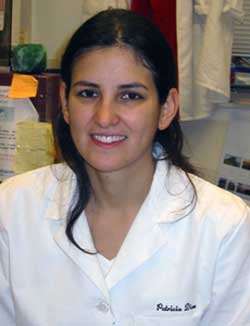
|
|
Patricia Diaz, Microbiologist, D.D.S., Ph.D., Postdoctoral Research Fellow, National Institute of Dental and Craniofacial Research (NIDCR), National Institutes of Health (NIH)
|
1. I chose this career because...
2. My typical workday involves...
3. What I like best/least about my work...
4. My career goals are...
5. Wen I'm not working, I like to...
6. Talents required for job versatility...
|
|
1. I chose this career because...
|
Back to Top

|
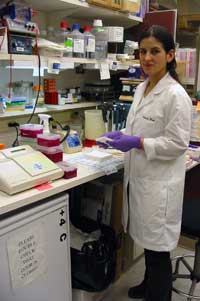
|
|
Patricia Diaz conducts an experiment at her lab bench.
|
I chose to become a microbiologist because I wanted to understand how microbes, though we cannot see them, are so important to human health and disease. I grew up in Colombia. When I was in high school, I had a preference for science subjects, such as biology or chemistry, and subjects related to art. I felt a desire to know about life, but I also wanted creativity. I found it very fascinating to study the biology of plants, animals, and human beings. However, I was not sure whether I wanted to do something related to science or to art.
Making a Career Choice
The educational system in Colombia is different compared to the one in the United States. In Colombia, right after high school, you have to decide what you want to do for the rest of your life. You choose a career, and go to the university. There are no steps in-between to help you decide your future. So at 16 years of age, I had to choose a career. For reasons that are not very clear to me now, I decided to become a dentist. Someone must have told me that dentistry combines biology with certain manual skills.
Dental School
The first years in dental school were exciting. I studied subjects such as physiology that explained the functioning of the human body. One of my other favorite subjects was immunology. I learned, for first time, about the wide range of amazingly sophisticated mechanisms that the body uses to defend itself against disease. When we started to work in the clinic and treat patients, I found it very rewarding and interesting.
We also had to develop a research project as part of our degree. I found an advisor that was interested in how bacteria colonize the tooth surfaces and how dental plaque develops. He suggested that my research group work on that topic. I undertook the task alone, after the other students abandoned me out of fear of the amount of reading and learning involved. I had the best time learning about bacteria. Just before completing my degree, I won a prize for my little research project.
Continuing Education
After graduating, I worked for two years as a general dentist. Although I was happy, there was something missing. The research bug had bitten me! So I looked for opportunities to further my education and to train myself as a researcher. I decided go to Australia, where I completed my undergraduate and graduate degree in the oral microbiology laboratory of the Dental School at The University of Adelaide.
Currently, I work as a postdoctoral research fellow at NIH. I realize now that research combines biology and creativity, and is the answer to the question I had in high school of what to study.
Education
- Doctor in Dental Surgery, Institute of Health Sciences, Medellin, Colombia
- Doctor of Philosophy, Oral Microbiology, University of Adelaide, Adelaide, Australia
- Bachelor of Science in Dentistry, Oral Microbiology, University of Adelaide, Adelaide, Australia
|
|
2. My typical workday involves...
|
Back to Top

|

|
|
Photo of a hybridization oven used to detect specific genes (top) and photo of a fume hood used for working with hazardous chemicals (bottom).
|
My typical workday at NIH starts around 9 am. The first thing I do is plan my experiments for the day, and then begin working on them.
Currently, I have 2 research projects:
- In one project, I study how bacteria colonize the surfaces of teeth just after brushing. It is estimated that there are around 500 different species of bacteria that live in the mouths of humans. Of these, only a few species arrive early to the tooth surfaces, just after we have cleaned our teeth. As days pass, if we don’t disturb the development of plaque, new species arrive and the complexity of the community of bacteria increases. I work in a project that tries to understand the interactions of the species that arrive first to the tooth surfaces. These species are called early colonizers. We have a system to study these microorganisms called the enamel chip model. It consists of small pieces of enamel, cut from extracted wisdom teeth that are placed in a small stent and worn by volunteers for periods of 4 to 16 hours. With these chips, we can mimic the development of plaque and analyze the bacteria that attaches to them.
- In my second project, I study the function of a protein (called OxyR) in a bacterium that causes gum disease. The function of this protein is studied by different molecular techniques. One of them is microarrays (or microarray technology). This is a powerful tool used to study the expression of all the genes (around 2000) in the bacteria, and how they change as the bacteria adapts to different environmental conditions.
A Collaborative and Academic Environment
I work in a laboratory with the principal investigator and four other microbiologists. We all have independent research projects, but as our skills are different, we collaborate and share our areas of expertise. We also meet once-a-week to discuss our work and to review the latest publications in the field, relevant to our work.
Typically during the summer, I supervise students that come to gain some research experience at NIH. Some of them are very enthusiastic and we have a very good time working together.
Equipment I Use
- Spectrophotometer – an instrument used to measure the concentrations of proteins, DNA, RNA, in a solution and the cell density of a bacterial culture.
- Hybridization oven – an instrument used to incubate membranes containing RNA or DNA that are incubated with a radioactive labeled compound that is used to detect a specific gene of interest on the membrane.
- Fume hood – an instrument designed to ensure proper ventilation of hazardous fumes and provides a safe working area for individuals using chemicals and other harmful compounds.
|
|
3. What I like best/least about my work...
|
Back to Top

|
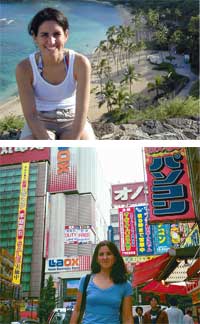
|
|
Patricia Diaz enjoys traveling to scientific conferences all over the world, e.g., Hawaii (top) and Japan (bottom).
|
What I like best about my work is the opportunity to think, solve problems, find answers to questions, formulate hypotheses and to prove or disproof their validity. As a microbiologist I can investigate those cool things microbes do while in their micro-world. As a dentist, I can understand the origin of disease, all the underlying factors that contributed to its development, and I can treat the patients with confidence. I hope one day my own research will also contribute to the well-being of people.
One very exciting aspect of my work is the opportunity to present my results at national and international conferences. I have traveled around Australia, to various cities in the United Sates, and to Japan to present my work and meet with other researchers from many different countries.
What I like least about my work are the ups and downs of research. It takes a long while to achieve results, so it is necessary to have a lot of patience and persistence.
|
|
4. My career goals are...
|
Back to Top

|
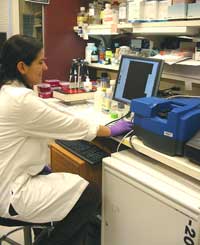
|
|
Patricia Diaz uses microarray technology to study gene expression.
|
My career goals are to continue my research in microbiology and combine research with clinical dental practice. Some day, I hope to have a laboratory in a dental school where I can develop research projects that continue to expand our understanding of the etiology of most oral diseases.
|
|
5. Wen I'm not working, I like to...
|
Back to Top

|
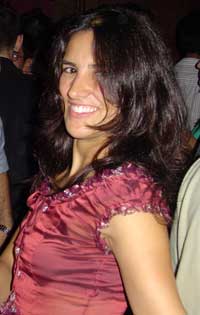
|
|
Patricia Diaz enjoys dancing in her free time.
|
When I’m not working, I like to dance to Latin music and get together with friends. I’m also trying to learn Flamenco, and it’s proving to be as “patience-breaking” as research (but also a lot of fun!) I also like reading and watching good films at the cinema.
|
|
6. Talents required for job versatility...
|
Back to Top

|
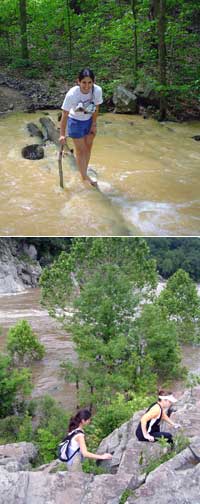
|
|
| |
Photos of Patricia Diaz on a recent hiking trip.
|
The talents necessary for this kind of job are patience, enthusiasm, critical thinking, persistence, intuition and creativity. Researchers can focus on a very small question for a long period of time, and are able to withstand the difficulties and disappointments created by the experiments that fail. They know that if they are patient enough, there is a reward at the end of the road.
One important aspect of choosing to be a microbiologist is the versatility of the job. There are many subspecialties within the field. There is also the possibility to work in clinical laboratories doing diagnostic microbiology, rather than in basic research.
|
|
|
|
 |